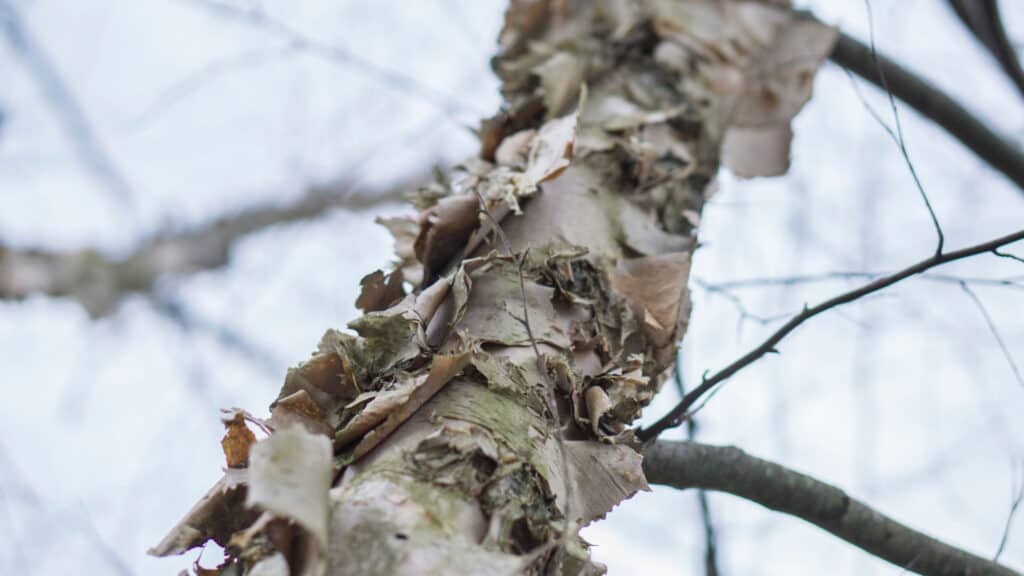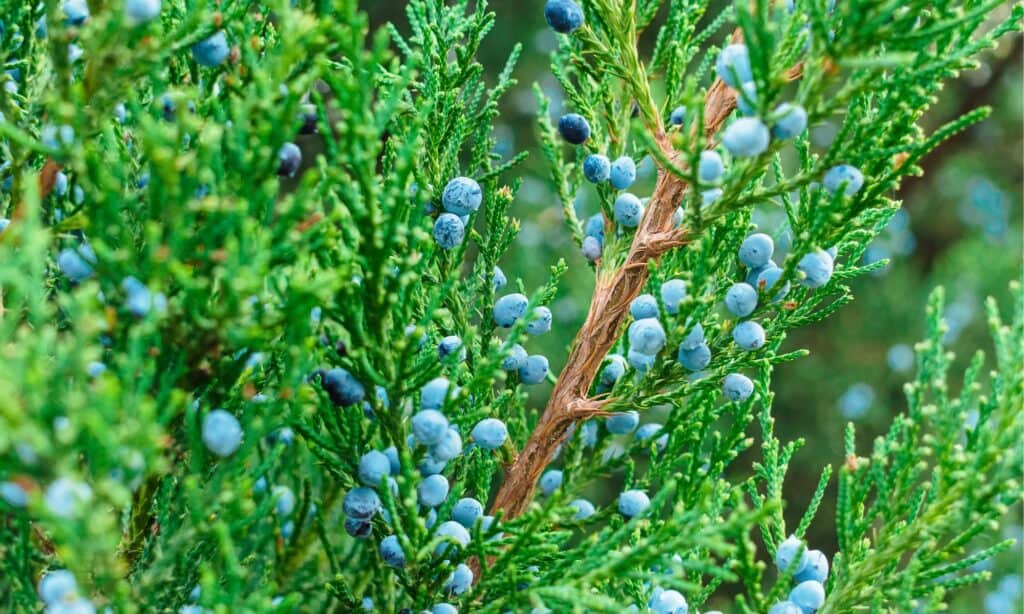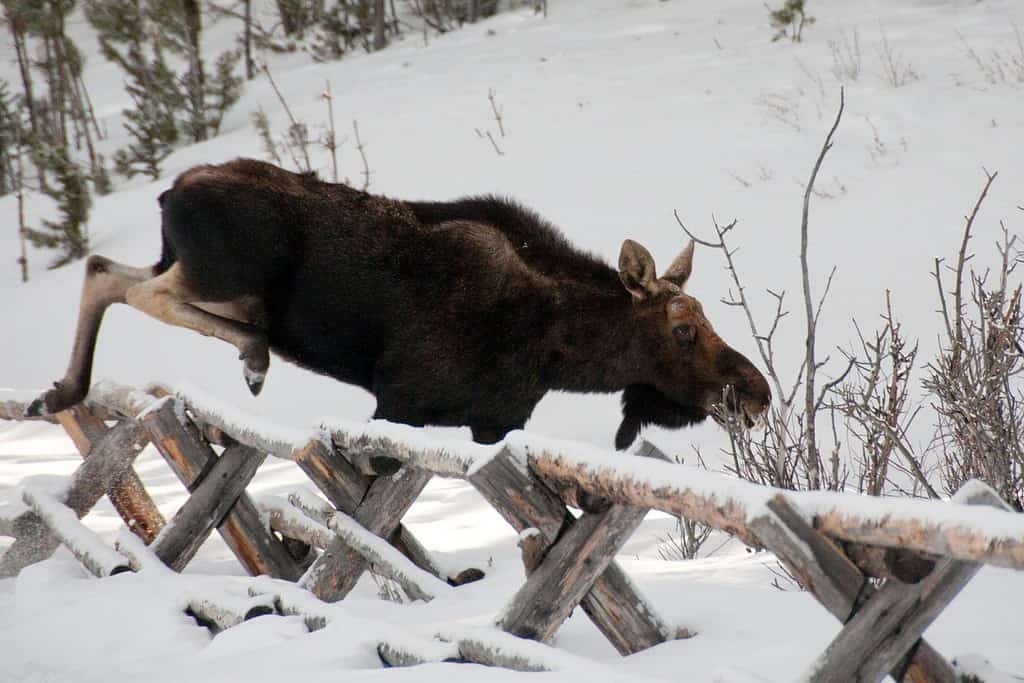What do moose eat? Their diet changes throughout the year for one key reason. Cold weather causes plants to enter dormancy, which makes it hard for moose to find enough to eat once leaves fall from trees and shrubs, and snow and ice cover the ground and waterways.
Spring and summer months are important for getting as much of a fat store as possible before winter arrives. In those months, moose eat 40 to 60 pounds of food per day. Moose eat aquatic plants, bark, buds, fruits, leaves, grasses, and twigs. Favorite trees and shrubs include aspen, birch, maple, willow, and viburnum, a species of flowering evergreen.
When winter arrives and food is scarce, moose must adapt and eat the plants they find. After eating, they slow down to prevent using more calories than they consume. What do moose eat in the winter? Here are the five common foods that form a moose’s winter diet.
Bark

Bark from aspen, birch, maple, and willow trees is the main component of a moose’s winter diet.
©thematthewhyatt/Shutterstock.com
The Maine Department of Inland Fisheries & Wildlife says the name moose comes from the Algonquin word “moosu,” which means bark stripper. It’s also believed moose comes from the Algonquin word “mooswa,” which means twig-eater. Both translations seem fitting. As the name suggests, bark is a crucial part of their diet.
Tree bark is easy to find, but the way a moose eats causes damage to trees, which frustrates property owners. Moose have incisors that scrape and rip large portions of bark from a tree in little time. The premolars and molars grind and break up that bark. Once they’ve eaten the food, they swallow it, but the process isn’t over.
Moose are ruminants, meaning they have a four-chambered stomach. They must eat, take a break, and regurgitate the food that’s partially digested. They will then continue to chew that partially digested food for as much as eight hours a day, which further breaks down the food before it’s swallowed again. This is a process called “chewing the cud.” Cows do the same thing.
Berries and Fruit

Moose also eat berries in the winter, particularly juniper berries that turn blue when ripe.
©iStock.com/Yuliya Shauerman
While a moose eats berries and fruit in the winter, they’re not specifically searching for fruit. Instead, they eat them while stripping needles, bark, and twigs from trees. Juniper berries are one of the most common winter berries that moose eat. They’ve also been known to eat mountain ash berries and any remaining apples or crab apples still hanging on trees that have appealing twigs or bark.
If there are fallen apples or shrubs with edible winter berries at ground level, they’ll kneel to eat them. It’s not a first choice, but moose will eat what plants and fruits help them make it through the winter months.
Pine Needles

Balsam fir is one of several trees that moose strip needles from to supplement their winter diet of bark and twigs.
©Sonia Horowitz/Shutterstock.com
Leaves are absent in the winter, so moose will eat the green needles from pine and fir trees like the balsam. They eat what is plentiful, and balsam fir is plentiful in northern woods. As needles aren’t as nutritional to moose, they have to supplement them with staples like bark and twigs.
Spruce Boughs

Moose eat smaller spruce boughs and tips through the winter.
©ditya_lotosa/Shutterstock.com
In winter months, moose will eat entire spruce boughs, specifically looking for the more tender tips. Their height enables them to reach higher up trees to where smaller spruce boughs and tips are located. They’re a bit easier to chew, have more nutrients, and are ample in quantity because other animals can’t access them.
Twigs

Moose eat a lot of twigs throughout the winter.
©Ginny Thomas/Shutterstock.com
Like bark, twigs are the main part of a moose’s diet in the winter. Willow twigs are the most popular, but a moose will forage for whatever twigs it can reach that are palatable, but aspen and willow are favorites. Most moose can reach upwards of eight feet without too much effort, which makes it easy for them to reach twigs that animals like deer can’t access. To eat those twigs, they grip it between their incisors and pull.
Twigs are tough and fibrous, but moose have microbes within their gut that help break the roughage down. In the summer, their first stomach holds up to 90 pounds of food, but it expands in the winter to hold as much as 112 pounds.
Watch for Moose Licking Road Salt

Bighorn sheep
are not the only animals that will stand in the roadway to lick salt. Moose will do the same, which leads to unexpected collisions on wintry roads.
©helivideo/iStock / Getty Images Plus via Getty Images
There’s one more thing to know about what moose eat in the winter. Summer’s aquatic plants and greens provide essential minerals, especially sodium. This explains why you might come across a moose licking snowbanks or road surfaces in the winter. They’re after the salt. Some people come out to their parked car to find a moose licking it.
Canada’s gone as far as placing digital signs on motorways to ensure people take action to discourage moose from this behavior. It causes problems with moose losing their fear of vehicles. Park Canada’s Wildlife Safety Quiz offers a quick tip on what to do if a moose tries to lick the salt off your car. It’s good advice to follow.
The photo featured at the top of this post is © equigini/iStock via Getty Images
Thank you for reading! Have some feedback for us? Contact the AZ Animals editorial team.







